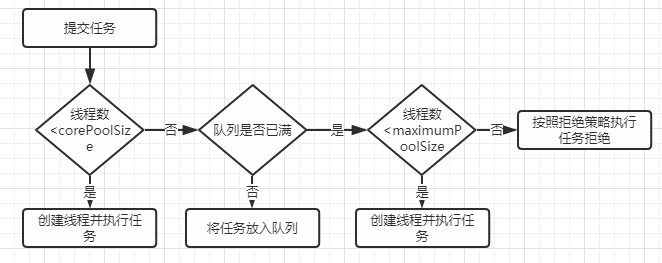ThreadPool实现原理
本文主要分析java.util.concurrent.ThreadPoolExecutor的实现原理,首先看它的构造函数:
public ThreadPoolExecutor(int corePoolSize,
int maximumPoolSize,
long keepAliveTime,
TimeUnit unit,
BlockingQueue<Runnable> workQueue,
ThreadFactory threadFactory,
RejectedExecutionHandler handler) {
if (corePoolSize < 0 ||
maximumPoolSize <= 0 ||
maximumPoolSize < corePoolSize ||
keepAliveTime < 0)
throw new IllegalArgumentException();
if (workQueue == null || threadFactory == null || handler == null)
throw new NullPointerException();
this.corePoolSize = corePoolSize;
this.maximumPoolSize = maximumPoolSize;
this.workQueue = workQueue;
this.keepAliveTime = unit.toNanos(keepAliveTime);
this.threadFactory = threadFactory;
this.handler = handler;
}
- corePoolSize:线程池中稳定保存的线程数(一开始会小于这个数)
- maximumPoolSize:线程池中最大线程数
- keepAliveTime and unit:大于最小线程数的线程空闲后存活时间
- workQueue:用于存放任务的阻塞队列
- threadFactory:用于创建线程的工厂类
- handler:当任务队列满了且线程数达到了最大时的饱和策略
对于IO密集型任务,线程数一般设为CPU数*2,对于计算密集型任务,线程数一般设为CPU数。
当调用execute方法时:
public void execute(Runnable command) {
if (command == null)
throw new NullPointerException();
/*
* Proceed in 3 steps:
*
* 1. If fewer than corePoolSize threads are running, try to
* start a new thread with the given command as its first
* task. The call to addWorker atomically checks runState and
* workerCount, and so prevents false alarms that would add
* threads when it shouldn't, by returning false.
*
* 2. If a task can be successfully queued, then we still need
* to double-check whether we should have added a thread
* (because existing ones died since last checking) or that
* the pool shut down since entry into this method. So we
* recheck state and if necessary roll back the enqueuing if
* stopped, or start a new thread if there are none.
*
* 3. If we cannot queue task, then we try to add a new
* thread. If it fails, we know we are shut down or saturated
* and so reject the task.
*/
int c = ctl.get();
if (workerCountOf(c) < corePoolSize) {
if (addWorker(command, true))
return;
c = ctl.get();
}
if (isRunning(c) && workQueue.offer(command)) {
int recheck = ctl.get();
if (! isRunning(recheck) && remove(command))
reject(command);
else if (workerCountOf(recheck) == 0)
addWorker(null, false);
}
else if (!addWorker(command, false))
reject(command);
}
其流程如图:

线程池状态变化如图:
- RUNNING: Accept new tasks and process queued tasks
- SHUTDOWN: Don't accept new tasks, but process queued tasks
- STOP: Don't accept new tasks, don't process queued tasks, and interrupt in-progress tasks
- TIDYING: All tasks have terminated, workerCount is zero, the thread transitioning to state TIDYING will run the terminated() hook method
- TERMINATED: terminated() has completed

shutdownNow终止线程的方法是通过调用Thread.interrupt()方法来实现的:
* <p> If this thread is blocked in an invocation of the {@link
* Object#wait() wait()}, {@link Object#wait(long) wait(long)}, or {@link
* Object#wait(long, int) wait(long, int)} methods of the {@link Object}
* class, or of the {@link #join()}, {@link #join(long)}, {@link
* #join(long, int)}, {@link #sleep(long)}, or {@link #sleep(long, int)},
* methods of this class, then its interrupt status will be cleared and it
* will receive an {@link InterruptedException}.
*
* <p> If this thread is blocked in an I/O operation upon an {@link
* java.nio.channels.InterruptibleChannel InterruptibleChannel}
* then the channel will be closed, the thread's interrupt
* status will be set, and the thread will receive a {@link
* java.nio.channels.ClosedByInterruptException}.
*
* <p> If this thread is blocked in a {@link java.nio.channels.Selector}
* then the thread's interrupt status will be set and it will return
* immediately from the selection operation, possibly with a non-zero
* value, just as if the selector's {@link
* java.nio.channels.Selector#wakeup wakeup} method were invoked.
*
* <p> If none of the previous conditions hold then this thread's interrupt
* status will be set. </p>
可以看到如果线程处于正常活动状态,那么会将该线程的中断标志设置为true,而无法中断当前的线程。所以,shutdownNow并不代表线程池就一定立即就能退出,它也可能必须要等待所有正在执行的任务都执行完成了才能退出。
正文到此结束
热门推荐
相关文章
Loading...











![[HBLOG]公众号](http://www.liuhaihua.cn/img/qrcode_gzh.jpg)

